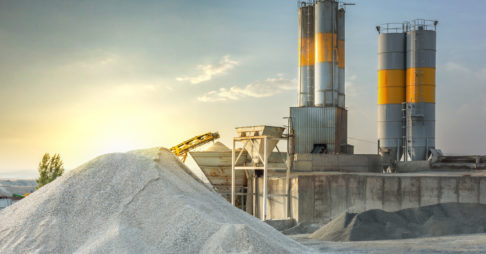As global vaccination rates increase, activity in the construction sector is accelerating. On top of the home improvement boom that we saw during the pandemic, many regions are experiencing a hot real estate market and a related boom in building activity.
With materials supply chains still recovering post-lockdown, the uptick in activity is driving demand—and costs—for materials to record levels. Cement prices are no exception. Around the world, costs are increasing, squeezing margins for producers in a highly competitive space.
- United States: Cement prices are increasing steadily year over year.
- United Kingdom: General construction material costs are up 10-50%.
- India: The price of cement has increased by 50-100%.
- Australia: Concrete prices have increased up to 10% across the country.

Cement Price Outlook
Recent research projects global demand for cement to rise between 2.9% and 5.3% per year to 4.7 billion metric tonnes valued at USD $340 billion by 2025.
Both cement, the key ingredient that gives concrete its strength, and concrete, offering incomparable performance in a variety of applications, are expected to remain hot commodities for the foreseeable future.
According to the report by Freedonia Group, demand will also be driven by several factors including:
- Rising urbanization boosting demand for cement in residential and non-residential markets
- Efforts by governments to improve housing stocks in developing countries, where concrete is the preferred construction material because of its durability
- Large-scale infrastructure projects in Asia/Pacific and Africa/Mideast regions, including those supported by China's Road & Belt Initiative
To counteract rising costs, concrete producers are seeking viable alternatives to cement.

How Concrete Producers Can Control Costs
As performance-based specifications become more commonplace, producers have more input into concrete mix designs. Supplementary Cementitious Materials (SCMs) and other innovative new technologies can replace cement in many applications without affecting performance.
Using Supplementary Cementitious Materials
SCMs can reduce the amount of cement required in a concrete mix. Examples include:
1. Fly Ash
Fly ash is a by-product of burning pulverized coal in power-generating plants. Depending on the application, the type of fly ash, specification limits, geographic location, and climate, fly ash can be used at levels ranging from 15% to 25% (most common) to 40% to 60% (when rapid setting time is not required), reducing emissions by roughly the same amount. However, several market forces are contributing to the decline in the supply of fly ash so concrete producers are seeking viable alternatives to this SCM.
2. Silica fume (SF)
SF is a by-product of silicon alloy production. The addition of SF decreases the permeability and diffusion of the concrete and is typically used at replacement levels between 3% and 10%. Replacement levels above 10% can lead to further durability improvements, but the workability and finishability of the concrete can be problematic.
3. Slag
Slag is a by-product of steel production. Slag reacts with both the water (latent hydraulic reaction) and the hydrated cement paste (pozzolanic reaction) in concrete and can replace 40-50% of the cement in a mix and up to 90% for some specialty applications. The carbon reduction from slag can be up to 30% depending on the replacement level specified.
4. Metakaolin
Metakaolin is a dehydroxylated form of the clay mineral kaolinite and can be used as cement replacement in concrete and typical replacement levels for metakaolin range from 5% to 10%.
These SCMs are a great alternative to cement. However, they are also subject to price volatility. Fly ash, for example, sees frequent fluctuations based on increasing demand and uncertain supply and in certain regions.
Implementing Innovative New Concrete Technologies
Several new innovations in concrete technology are focused on reducing the amount of cement in content mix designs. These innovations deliver several benefits including cost reduction and improved environmental sustainability.
Carbon capture, utilization, and storage (CCUS) technologies are arguably the most exciting of these innovations. Carbon capture makes it possible to capture up to 100% of the carbon emissions from cement manufacturing. These captured emissions can be stored safely underground, injected back into concrete, or used to make other products like synthetic aggregates or fuels.
Many of the key players in the CCUS space have built innovations that also reduce cement.
CarbonCure is one such solution. CarbonCure’s retrofit technology can be installed in any ready mix concrete plant today. It injects CO2 into fresh concrete in order to maintain its strength and performance. These improvements enable concrete producers to realize cost savings through cement reduction and mix optimization.
If you’re interested in learning more about CarbonCure, contact us.

Razing a Common Misunderstanding: Early-Age Carbonation vs. Atmospheric Carbonation in Concrete

